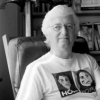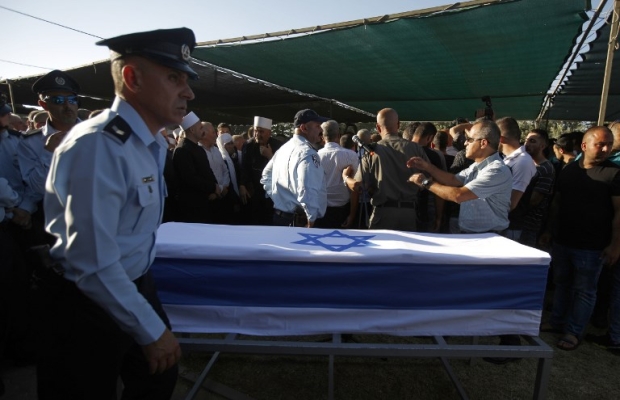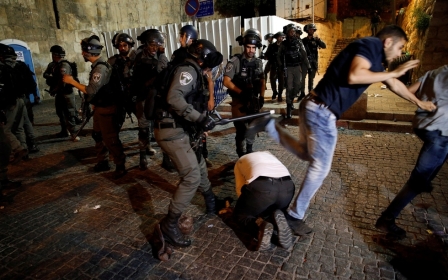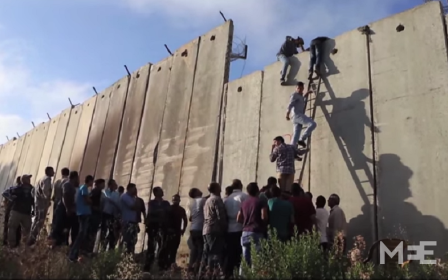Unprecedented and combustible: Why the boycott of Al-Aqsa matters

Last Friday, three Israeli Palestinian citizens from of the northern town of Umm al Fahm attacked police outside the Haram al-Sharif, the third holiest site in Islam (known to Israeli Jews as the Temple Mount).
Over the last few years, Israel has imposed a series of measures restricting Muslims access to the site, while also periodically mounting armed assaults by police on the al-Aqsa mosque and worshippers inside it.
Such breaches of the sanctity of the holy place have angered Muslims around the world, but particularly Palestinians both in Israel and the West Bank. Much of the sustained violence of “lone-wolf” attacks against Israeli targets, which have left nearly 50 Israeli and 250 Palestinian dead, has been motivated by religious outrage at Israel’s conduct.
Friday’s attack was the most daring in recent memory. Three members of a local clan, each named Muhammad Jabareen, managed to smuggle weapons into Jerusalem’s Old City, then retrieve them and fire on the police. They killed two Israeli Druze policemen and lightly wounded another.
After attacking the police, the gunmen then fled into the Haram al Sharif, where Israeli security forces hunted and executed them. A video recorded by Palestinians shows one of the attackers lying on the ground unarmed. After he rises and tries to run away, he is gunned down by a fusillade of bullets.
It’s common in such situations for Israeli forces to kill attackers whether or not they are armed or have caused harm to others. The method of execution is sometimes called the “kill shot”. Once a Palestinian has killed or injured an Israeli in such as assault, their life is considered forfeited in most cases.
All blame, no responsibility
In other countries after a major security breach, authorities would closely examine the circumstances which permitted the incident to happen, accountability that the public would loudly demand.
While Israeli security officials may be undertaking such an examination, few are questioning how the Shin Bet and police permitted three armed men to launch such a deadly assault. Instead, these two agencies are engaged in a finger-pointing war to ascribe blame to one another. Meanwhile, no one takes real responsibility.
The main dispute involves whether metal detectors, which were installed immediately after the assault, should have been used earlier, and whether they would have prevented the attack.
However, there is no such guarantee unless the Israeli police are willing to compel every Palestinian entering any gate of the Old City to submit to such inspections. That would require the complete militarisation of one of the holiest cities in the world and the placement of scores, if not hundreds, of metal detector units. It would mean long lines for those seeking to enter, including for tourists who fuel a critical portion of the local economy.
The officers and the shooters
The ethnic identity of both the dead police officers and their killers is of particular importance. The policemen were Israeli Druze. Their religion is an offshoot of Islam, but has always been considered a minority and sometimes a persecuted one.
Since the founding of Israel in 1948, the state has cultivated friendly relations with the Druze and they have reciprocated by serving in the IDF, as opposed to the rest of the Palestinian Muslims who refuse military service.
Though this has been changing in recent years, Druze are seen as even more gung-ho than the average Israeli Jewish soldier. Druze soldiers have been involved in several controversial killings of unarmed civilians in Gaza and elsewhere.
The relationship between Druze and Israeli Jews seems to follow a common colonial pattern in which the ruling power seeks to divide a majority native population by favouring a single minority tribe at the expense of the rest. In other words, divide and conquer.
The shooters were, as I mentioned, from a northern Israeli town. Umm al Fahm is a hotbed of support for the northern branch of the Islamic Movement, led by Muslim leader Imam Raed Salah. It’s also his hometown. He has been routinely arrested for inciting resistance to Israel’s management of Jerusalem’s holy Muslim sites.
Over the past few years, most attacks by Palestinians against Israelis have been perpetrated by those living in or around East Jerusalem or in the West Bank. Relatively few such attacks have involved Palestinian citizens of Israel who are generally considered a more loyal and “trustworthy” population than those outside Israel (in the West Bank and Gaza).
With such unrest now affecting the Israeli Palestinian minority, Israel enters an even more fraught, unstable period than it faced in the past.
Resistance to crackdown
The official Israeli response to the attack was swift and severe. The entire Haram al-Sharif was closed for the first time since a disturbed Australian Christian evangelical attempted to begin a holy war by blowing up the al-Aqsa mosque in 1969.
Going even further, security forces sealed off the entire Old City with multiple checkpoints designed to prevent anyone from entering the walled Palestinian portion of the city. Merchants with stores in the souk were threatened with heavy fines if they opened their shops. This, too, was an unprecedented step.
On Monday, Israel reopened the Haram al-Sharif and partially reopened the Old City, although a majority of the gates into the area remained closed. But there were radical changes in security procedures. Security officials had installed metal detectors and video surveillance unilaterally. This was a violation of the so-called status quo, to which Prime Minister Benjamin Netanyahu falsely claimed Israel was adhering.
Under such regulations, any changes to the holy sites must be agreed by both Jordanian (who are the stewards of the Muslim sites) and Israeli authorities. But Israel enforced these changes without any consultation.
If Britain repressed Catholics
The result has been a sustained Muslim boycott of the Noble Sanctuary. Worshippers have prayed just outside the new metal detector installation for the past three days, refusing to undertake this demeaning act. Muslims view this as a desecration of the sacred status of the site and an insult to their faith.
Imagine if Britain, which has a state Anglican religion, determined that Catholic worshippers posed a threat to national security and imposed metal detectors, video cameras and a massive police presence outside the leading Catholic cathedral. There would certainly be a massive uproar, not just among Catholics, but likely among Anglicans as well.
The Israeli political class treats Palestinian issues in a schizoid manner. It refuses to see Palestinian interests as part of overall Israeli interests. They are bifurcated into two separate classes: Israeli Jewish interests which are paramount and everything else which is isolated and secondary.
That’s how Netanyahu, facing a massive crisis of confidence with the Palestinian Israeli minority, can ignore the matter and begin a five-day tour to central European capitals (Budapest and Warsaw among them) whose governments largely support his own Islamophobic, anti-refugee agenda.
Israeli media view the trip as a desperate attempt to get out from under the weight of a growing scandal involving the tainted $10bn dollar purchase of German nuclear submarines.
No one suggested that Netanyahu should postpone his trip to deal with the Jerusalem crisis. That isn’t even an afterthought in his political considerations, although the embattled prime minister did just announce he was cutting his visit short by one day.
- Richard Silverstein writes the Tikun Olam blog, devoted to exposing the excesses of the Israeli national security state. His work has appeared in Haaretz, the Forward, the Seattle Times and the Los Angeles Times. He contributed to the essay collection devoted to the 2006 Lebanon war, A Time to Speak Out (Verso) and has another essay in the upcoming collection, Israel and Palestine: Alternate Perspectives on Statehood (Rowman & Littlefield).
The views expressed in this article belong to the author and do not necessarily reflect the editorial policy of Middle East Eye.
Photo: Palestinians demonstrate next to the offices of UNSCO (United Nations Special Coordinator for the Middle East Peace Process) against Israel's siege of the Gaza Strip and in solidarity with Muslims boycotting prayers at Jerusalem's Al-Aqsa Mosque on 19 July 2017 in Gaza City (AFP)
This article is available in French on Middle East Eye French edition.
Middle East Eye propose une couverture et une analyse indépendantes et incomparables du Moyen-Orient, de l’Afrique du Nord et d’autres régions du monde. Pour en savoir plus sur la reprise de ce contenu et les frais qui s’appliquent, veuillez remplir ce formulaire [en anglais]. Pour en savoir plus sur MEE, cliquez ici [en anglais].







